Keto Diet Meal Prep List
Not sure what to eat on a ketogenic diet? Here's a quick food list for you to reference.
Below you'll find a brief overview of what you can eat. Scroll further down to see more details on each section.
Being on a diet isn't the easiest thing in the world, especially when you don't know what you should eat. We've put together this ketogenic diet food list to help people out there make decisions on what they are eating and shopping for.
Below you can find a quick visual guide to what to eat on a ketogenic diet. Let's go over some of the commonly identifiable items that people use on keto:
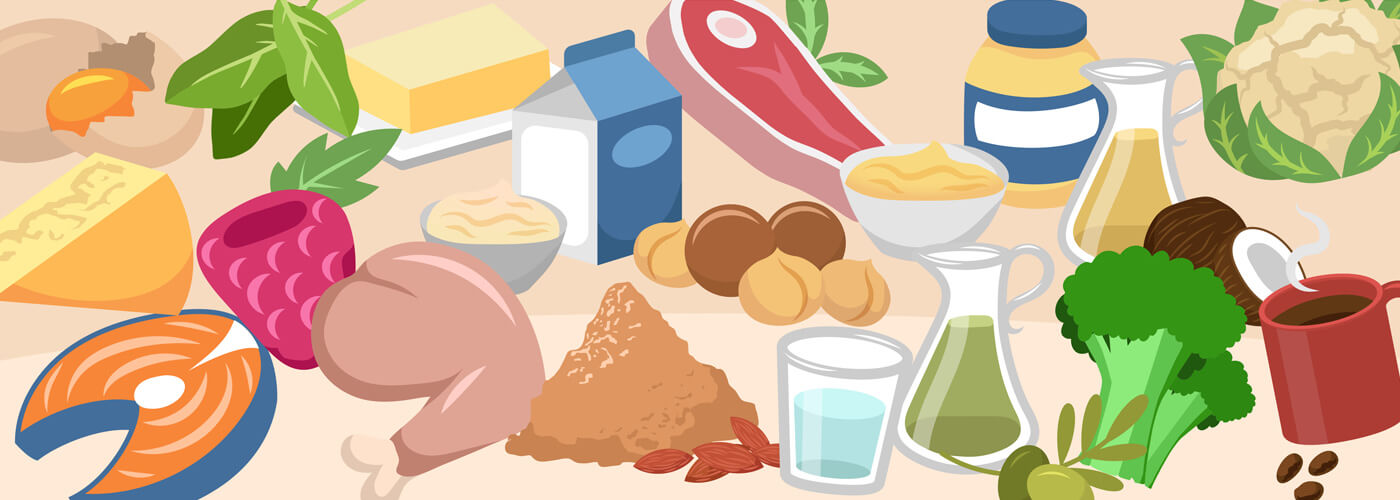
All of the food above sticks to the strict 5% carbohydrate allowance that we use on keto. In general, you can eat from the following food groups:
- Fats & Oils. Try to get your fat from natural sources like meat and nuts. Supplement with saturated and monounsaturated fats like coconut oil, butter, and olive oil.
- Protein. Try to stick with organic, pasture-raised and grass-fed meat where possible. Most meats don't have added sugar in them, so they can be consumed in moderate quantity. Remember that too much protein on a ketogenic diet is not a good thing.
- Vegetables. Fresh or frozen doesn't matter. Stick with above ground vegetables, leaning toward leafy/green items.
- Dairy. Most dairy is fine, but make sure to buy full-fat dairy items. Harder cheeses typically have fewer carbs.
- Nuts and Seeds. In moderation, nuts and seeds can be used to create some fantastic textures. Try to use fattier nuts like macadamias and almonds.
- Beverages. Stay simple and stick to mostly water. You can flavor it if needed with stevia-based flavorings or lemon/lime juice.
If you scroll down, you can see in-depth breakdowns of each section along with some ideas on what types of food to eat! If you're not much of the planning type and would rather follow along to get meal ideas, take a look at our Keto Academy Program >
Fats and Oils
Fats will be the majority of your daily calorie intake when you are on a ketogenic diet, so choices should be made with your likes and dislikes in mind. They can be combined in many different ways to add to your meals – sauces, dressings, or just simply topping off a piece of meat with butter.
Fats are vital to our bodies, but they can also be dangerous if you are consuming too much of the wrong types of fats. There are a few different types of fat that are involved in a ketogenic diet. Different foods usually have various combinations of fats, but the unhealthy fats are easy to avoid. Here's a brief overview:
- Saturated Fats. Eat these. Some examples of these are butter, ghee, coconut oil, and lard.
- Monounsaturated Fats. Eat these. Some examples of these are olive, avocado, and macadamia nut oils.
- Polyunsaturated Fats. Know the difference. Naturally occurring polyunsaturated fats in animal protein and fatty fish are great for you, and you should eat these. Processed polyunsaturated fats in "heart healthy" margarine spreads are bad for you.
- Trans Fats. Completely avoid. These are processed fats that are chemically altered (hydrogenated) to improve shelf life. Avoid all hydrogenated fats, such as margarine, as they're linked to heart disease.
Saturated and monounsaturated fats such as butter, macadamia nuts, avocado, egg yolks, and coconut oil are more chemically stable and less inflammatory to most people, so they are preferred. Below, you can see some common ways to increase the amounts of fat you eat on a ketogenic diet.
You also want to have a balance between your omega 3's and omega 6's, so eating things like wild salmon, tuna, trout, and shellfish can help provide a balanced diet of Omega-3's. If you don't like fish, or just prefer not to eat it, we suggest taking a small fish oil supplement. You can also take krill oil for omega 3's if you are allergic.
Keep an eye on your intake for nut or seed based foods, as they can be quite high in inflammatory omega 6's. These include items like almonds, walnuts, pine nuts, sunflower oil and corn oil. Eating fatty fish and animal meat, keeping snacking to a minimum, and not over-indulging in dessert items that are dense in almond flour is usually enough to keep your omega's at normal ranges.
Essential fatty acids (the omegas) provide core functions to the human body, but they are often times out of balance when on a standard diet. On keto, with a little bit of preparation, your omega fatty acids are easily manageable. If you want to know more about essential fatty acids, omegas, and how they interact with our body on a ketogenic diet, you can read more here >
Some ketogenic diet foods that are ideal for fats and oils (organic and grass-fed sources are preferred):
- Fatty Fish
- Animal Fat (non-hydrogenated)
- Lard
- Tallow
- Avocados
- Egg Yolks
- Macadamia/Brazil Nuts
- Butter/Ghee
- Mayonnaise
- Coconut Butter
- Cocoa Butter
- Olive Oil
- Coconut Oil
- Avocado Oil
- Macadamia Oil
- MCT Oil
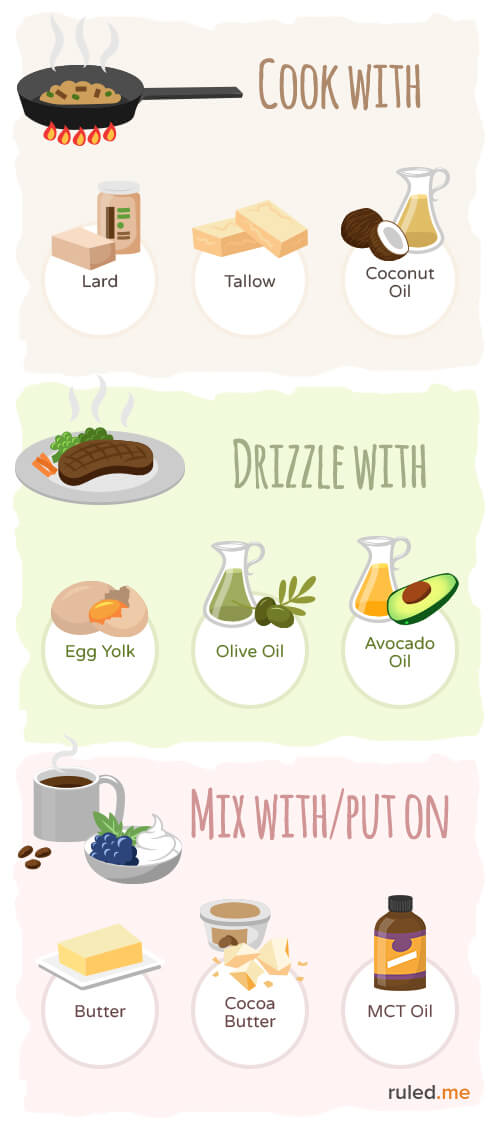
If you're using vegetable oils (olive, soybean, flax, or safflower) choose the "cold pressed" options if they are available.
If you tend to fry things up, try to go after non-hydrogenated lards, beef tallow, ghee, or coconut oil since they have higher smoke points than other oils. This allows less oxidization of the oils, which means you get more of the essential fatty acids.
Protein
Below, you'll find a visual list of proteins that are commonly consumed on a ketogenic diet. Note that the higher the amount of protein, the less you will want to consume.
Your best bet when it comes to protein is choosing pasture-raised and grass-fed. This will minimize your bacteria and steroid hormone intake. Try to choose the darker meat where possible with poultry, as it is much fattier than white meat. Eating fatty fish is a great way to get omega 3's in as well.
When it comes to red meat, there's not too much to avoid. Cured meats and sausages can sometimes have added sugars and added processed ingredients. If you eat steak, try to choose fattier cuts like ribeye. If you like hamburger meat (ground beef), try to choose fattier ratios like 85/15 or 80/20 in some cases.
One thing you do need to be careful of when dealing with meat is your protein intake. Too much protein on a ketogenic diet can lead to lower levels of ketone production and increased production of glucose. You want to aim for nutritional ketosis, so you must not over-consume on protein.
Try to balance out the protein in your meals with fattier side dishes and sauces. If you choose to eat lean beef, you have to be especially careful with the portioning of protein. Jerky and other beef snacks can add up in protein very fast, so make sure to pair it with something fatty – like cheese!
Note: If you don't eat pork or beef, you can always substitute lamb in its place since it is very fatty. Replace cuts of meat like bacon with similar, leaner items. Add extra fat if needed.
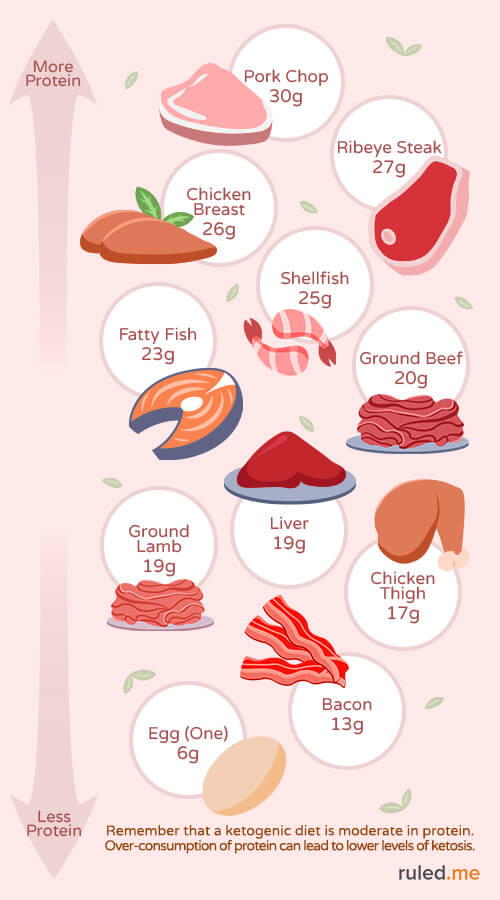
Some examples of how to get your protein in on a ketogenic diet are below:
- Fish. Preferably eating anything that is caught wild like catfish, cod, flounder, halibut, mackerel, mahi-mahi, salmon, snapper, trout, and tuna. Fattier fish is better.
- Shellfish. Clams, oysters, lobster, crab, scallops, mussels, and squid.
- Whole Eggs. Try to get them free-range from the local market if possible. You can prepare them in many different ways like fried, deviled, boiled, poached, and scrambled.
- Beef. Ground beef, steak, roasts, and stew meat. Stick with fattier cuts where possible.
- Pork. Ground pork, pork loin, pork chops, tenderloin, and ham. Watch out for added sugars and try to stick with fattier cuts.
- Poultry. Chicken, duck, quail, pheasant and other wild game.
- Offal/Organ. Heart, liver, kidney, and tongue. Offal is one of the best sources of vitamins/nutrients.
- Other Meat. Veal, Goat, Lamb, Turkey and other wild game. Stick with fattier cuts where possible.
- Bacon and Sausage. Check labels for anything cured in sugar, or if it contains extra fillers. Don't be overly concerned with nitrates.
- Nut Butter. Go for natural, unsweetened nuts and try to stick with fattier versions like almond butter and macadamia nut butter. Legumes (peanuts) are high in omega 6's so be careful about over-consumption.
Here's a nutritional list of some of the most commonly consumed proteins on keto and their respective nutritional profile. Keep in mind that you still need to balance your protein intake with fat.
| Keto Protein Source | Calories | Fats (g) | Net Carbs (g) | Protein (g) |
| Ground beef (4 oz., 80/20) | 280 | 23 | 0 | 20 |
| Ribeye steak (4 oz.) | 330 | 25 | 0 | 27 |
| Bacon (4 oz.) | 519 | 51 | 0 | 13 |
| Pork chop (4 oz.) | 286 | 18 | 0 | 30 |
| Chicken thigh (4 oz.) | 250 | 20 | 0 | 17 |
| Chicken breast (4 oz.) | 125 | 1 | 0 | 26 |
| Salmon (4 oz.) | 236 | 15 | 0 | 23 |
| Ground lamb (4 oz.) | 319 | 27 | 0 | 19 |
| Liver (4 oz.) | 135 | 5 | 0 | 19 |
| Egg (1 large) | 70 | 5 | 0.5 | 6 |
| Almond butter (2 tbsp.) | 180 | 16 | 4 | 6 |
Remember that protein is always to be consumed in moderation. If you need help knowing how much protein to eat, we recommend visiting the Keto Calculator >
Vegetables and Fruit
Below, you'll find a visual list of fruit and veggies that are commonly consumed on a ketogenic diet. Note that the higher the amount of carbs, the less you will want to consume.
Vegetables are a paramount part of a healthy keto diet, but sometimes we're stuck with decisions we might regret later. Some vegetables are high in sugar and don't cut it nutritionally – so we need to weed them out.
The best type of vegetables for a ketogenic diet are high in nutrients and low in carbohydrates. These, as most of you can guess, are dark and leafy. Anything that resembles spinach or kale will fall into this category and will be the best thing to include in anything you can.
Try to go after cruciferous vegetables that are grown above ground, leafy, and green. If you can opt for organic as there are fewer pesticide residues, but if you can't then don't worry. Studies show that organic and non-organic vegetables still have the same nutritional qualities. Both frozen and fresh vegetables are good to eat.
Note: Vegetables that grow below ground can still be consumed in moderation – you just have to be careful about the number of carbs that they have. Usually, underground vegetables can be used for flavor (like half an onion for an entire pot of soup) and easily moderated.
In general, there's no fitting rule that works perfectly. Try to choose your vegetables with carbohydrates in mind and portion them based on their carb counts.

Be careful and monitor the vegetables (and their respective carb counts) you add to any of your meals. Especially try to limit your intake of:
- Higher carb vegetables. This includes onion, parsnip, garlic, mushrooms, and squash.
- Nightshades. This includes tomato, eggplant, and peppers.
- Berries. This includes raspberries, blackberries, and blueberries.
- Citrus. This includes lemon, lime, and orange juice (or zest) in water and in recipes.
- Completely avoid starchy vegetables and large fruits like potatoes and bananas.
Here's a nutritional list of some of the more commonly consumed vegetables on keto. Keep in mind that the weights are the same of everything listed so that it will impact the skew of the carb counts. For example, in a meal you may have 6 oz. of broccoli in the side, but you would not have 6 oz. worth of berries in the morning. You may mix 6 oz. of berries into a pudding with 4 servings.
| Keto Veggie/Fruit Source | Calories | Fats (g) | Net Carbs (g) | Protein (g) |
| Cabbage (6 oz.) | 43 | 0 | 6 | 2 |
| Cauliflower (6 oz.) | 40 | 0 | 6 | 5 |
| Broccoli (6 oz.) | 58 | 1 | 7 | 5 |
| Spinach (6 oz.) | 24 | 0 | 1 | 3 |
| Romaine Lettuce (6 oz.) | 29 | 1 | 2 | 2 |
| Green Bell Pepper (6 oz.) | 33 | 0 | 5 | 1 |
| Baby Bella Mushrooms (6 oz.) | 40 | 0 | 4 | 6 |
| Green Beans (6 oz.) | 26 | 0 | 4 | 2 |
| Yellow Onion (6 oz.) | 68 | 0 | 12 | 2 |
| Blackberries (6 oz.) | 73 | 1 | 8 | 2 |
| Raspberries (6 oz.) | 88 | 1 | 8 | 2 |
You may notice that fruits and vegetables that grow underground tend to have higher carb counts, so they must be monitored and limited. To see a full list of low carb vegetables, take a look at thebest low-carb vegetables list >
Dairy Products
Below, you'll find a visual list of dairy that is commonly consumed on a ketogenic diet. Note that the higher the amount of carbs, the less you will want to consume.
Dairy is commonly consumed in tandem with meals on keto. Try to keep your dairy consumption to a moderate level. Most of your meals should be coming from protein, vegetables, and added fats/cooking oils.
Raw and organic dairy products are preferred here, if available. Highly processed dairy normally has 2-5x the number of carbohydrates as raw/organic dairy so it does add up over time. Make sure to choose full fat products over fat-free or low-fat as they will have significantly more carbs and less "filling" effects.
If you have lactose sensitivities, stick with very hard and long-aged dairy products as they contain much less lactose. Some examples of dairy you can eat on keto are:
- Greek yogurt
- Heavy whipping cream
- Spreadables including cottage cheese, cream cheese, sour cream, mascarpone, creme fraiche, etc.
- Soft Cheese including mozzarella, brie, blue, colby, monterey jack, etc.
- Hard Cheese including aged cheddar, parmesan, feta, swiss, etc.
- Mayonnaise and mayo alternatives that include dairy.
Dairy is a great way to add extra fats into meals by creating sauces or fatty side dishes like creamed spinach, but always remember that it does have protein in it as well. You should always take this into account when pairing dairy with protein-heavy dishes.

Below you'll find a nutritional list of the most commonly consumed dairy items on keto. By far the most common dairy items used are heavy cream (for tea/coffee) and cheese (for added fats in meals). Note that the nutrition values in the table are based on 1 oz. servings while the visual guide is based on 100g servings (~1/2 cup).
| Keto Dairy Source | Calories | Fats (g) | Net Carbs (g) | Protein (g) |
| Heavy cream (1 oz.) | 100 | 12 | 0 | 0 |
| Greek yogurt (1 oz.) | 28 | 1 | 1 | 3 |
| Mayonnaise (1 oz.) | 180 | 20 | 0 | 0 |
| Half n' half (1 oz.) | 40 | 4 | 1 | 1 |
| Cottage cheese (1 oz.) | 25 | 1 | 1 | 4 |
| Cream Cheese (1 oz.) | 94 | 9 | 1 | 2 |
| Mascarpone (1 oz.) | 120 | 13 | 0 | 2 |
| Mozzarella (1 oz.) | 70 | 5 | 1 | 5 |
| Brie (1 oz.) | 95 | 8 | 0 | 6 |
| Aged Cheddar (1 oz.) | 110 | 9 | 0 | 7 |
| Parmesan (1 oz.) | 110 | 7 | 1 | 10 |
Some people experience slower weight loss when over-consuming cheese. If you notice that you have hit a plateau or slowed down in weight loss, you may want to consider reducing the amount of dairy you eat. To see a full list of low carb dairy products, take a look at the best keto dairy list >
Nuts and Seeds
Below, you'll find a visual list of nuts that are commonly consumed on a ketogenic diet. Note that the higher the amount of carbs, the less you will want to consume.
Nuts and seeds are best when they are roasted to remove any anti-nutrients. Try to avoid peanuts if possible, as they are legumes which are not highly permitted in the ketogenic diet food list.
Typically raw nuts can be used to add flavorings or texture to meals. Some people choose to consume them as snacks – which can be rewarding but may work against weight loss goals. Snacking, in general, will raise insulin levels and lead to slower weight loss in the long term.
Nuts can be a great source of fats, but you always have to remember that they do have carbohydrate counts that can add up quickly. It's also particularly important to note that they do contain protein as well. Nut flours especially can add up in protein rather fast – so be wary of the amount you use.
Nuts can also be high in omega 6 fatty acids, so it's good to be careful with the amount you consume. For typical eating, you want to stick with fattier and lower carbohydrate nuts.
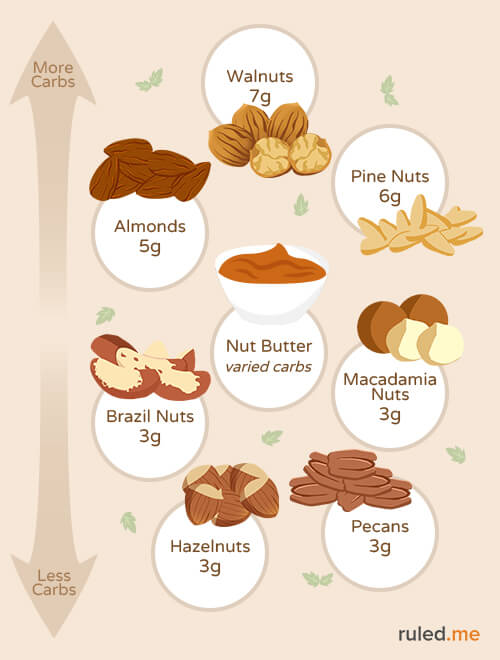
Next time you're thinking about opening a new bag of nuts to eat, consider what's better for you on keto from the following:
- Fatty, low carbohydrate nuts. Macadamia nuts, brazil nuts, and pecans can be consumed with meals to supplement fat.
- Fatty, moderate carbohydrate nuts. Walnuts, almonds, hazelnuts, peanuts, and pine nuts can be used in moderation to supplement for texture or flavor.
- Higher carbohydrate nuts. Pistachios and cashews should rarely be eaten or avoided as they're very high in carbohydrates (2 handfuls of cashews is almost a full day's allowance of carbs).
Note: If you have a nut allergy, a common substitution for almond flour is sunflower seed flour. Just keep in mind that this has higher levels of omega 6 fatty acids.
Below you'll see a nutritional list of some examples of the most commonly consumed nuts on keto. Remember that snacking will slow down weight loss:
| Keto Nut Source | Calories | Fats (g) | Net Carbs (g) | Protein (g) |
| Macadamia Nuts (2 oz.) | 407 | 43 | 3 | 4 |
| Brazil Nuts (2 oz.) | 373 | 37 | 3 | 8 |
| Pecans (2 oz.) | 392 | 41 | 3 | 5 |
| Almonds (2 oz.) | 328 | 28 | 5 | 12 |
| Hazelnuts (2 oz.) | 356 | 36 | 3 | 9 |
Below, you'll find a visual list of nut and seed flours that are commonly consumed on a ketogenic diet. Note that the higher the amount of carbs, the less you will want to consume.
Nut and seed flours are great to substitute for regular flour. Commonly consumed on keto, seeds and nuts are frequently seen in baked recipes and dessert recipes. We often see the use of nuts (in almond flour) and seeds (in flaxseed meal) but should be eaten in moderation.
You can usually use a mix of multiple flours to get a realistic texture in baking recipes. Combining flours and experimenting with your baking can lead to much lower net carb counts in recipes. We think these lemon poppyseed muffins (a mix of almond flour and flaxseed meal) make a great texture when combined with the fats from the heavy cream and butter.
Remember that different flours act in different ways as well. For example, you would only need about half the amount of coconut flour as you would almond flour. Coconut flour is much more absorptive and generally, requires more liquid.
Besides baking, you can also use these flours as a breading when frying foods or even as a pizza base!

When you get creative enough, there's always a way to make a low-carb version of an old favorite. If you need some ideas, check out our keto cheat sheet >
You can see a nutritional list of some examples of commonly consumed keto nut/seed items below:
| Keto Nut/Seed Baking Source | Calories | Fats (g) | Net Carbs (g) | Protein (g) |
| Almond Flour (2 oz.) | 324 | 28 | 6 | 12 |
| Coconut Flour (2 oz.) | 120 | 4 | 6 | 4 |
| Chia Seed Meal (2 oz.) | 265 | 17 | 3 | 8 |
| Flaxseed Meal (2 oz.) | 224 | 18 | 1 | 8 |
| Unsweetened Coconut (2 oz.) | 445 | 40 | 8 | 4 |
Water and Beverages
Below, you'll find a visual list of beverages that are commonly consumed on a ketogenic diet. Note that the more restricted they are, the less you will want to consume.
The ketogenic diet has a natural diuretic effect, so dehydration is common for most people starting out. If you're prone to urinary tract infections or bladder pain, you have to be especially prepared.
The eight glasses of water we're recommended to drink? Drink those, and then some more. Considering we're made up of about two-thirds water, hydration plays a substantial role in our everyday life. We recommend that you try to drink as close to a gallon of water a day as possible.
Many people choose ketoproof coffee or tea in the morning to ramp up energy with added fats. While it is a great thing, it's also important to consume flavored beverages in moderation. This is amplified when it comes to caffeine as too much will lead to weight loss stalls; try to limit yourself to a maximum of 2 cups of caffeinated beverages a day.
Note: Many people experience the Keto Flu when transitioning to keto due to dehydration and lack of electrolytes. Make sure that you replenish your electrolytes and drink plenty of fluids. An easy way to do this is by drinking bone broth or sports drinks sweetened with sucralose or stevia.
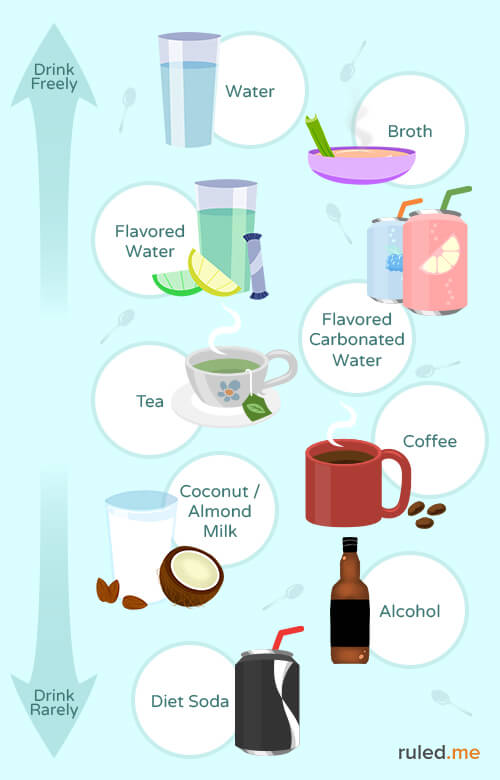
Some examples of commonly consumed beverages on keto are below:
- Water. This will be your staple, go-to source for hydration. You can drink still or sparkling water.
- Broth. Loaded with vitamins and nutrients. More importantly, it will kickstart your energy by replenishing your electrolytes.
- Coffee. Improves mental focus and has some added weight loss benefits.
- Tea. Has the same effects as coffee, but many don't enjoy tea. Try to stick with black or green.
- Coconut/Almond milk. You can use the unsweetened versions in the carton from the store to replace your favorite dairy beverage.
- Diet soda. Try to severely reduce or completely stop drinking this. It can lead to sugar cravings and sometimes insulin spikes in the long run.
- Flavoring. The small packets that are flavored with sucralose or stevia are fine. You can alternatively add a squeeze of lemon, lime, or orange to your water bottle.
- Alcohol. Choose hard liquor. More beer and wine will be too high carb to consume. Frequent consumption of alcohol will slow weight loss down. Read more here >
Many people enjoy keeping themselves accountable by creating challenges for themselves. We use a 32 oz. water bottle and put four hair ties around it. Each time we finish a bottle, we take away a hair tie. Keep drinking until there's no more!
Spices and Cooking
Below, you'll find a visual idea of spices that are commonly consumed on a ketogenic diet. Even small ingredients can add up in carbs; make sure to monitor spices and condiments that you add to your meals.
Seasonings and sauces are a tricky part of ketogenic diet foods, but people use them on a regular basis to add flavor to their meals. The easiest way to remain strict here is to avoid processed foods. There are many low carb condiments and products on the market, and there's no way to list them all. A handful of them are great, but the majority use high glycemic index sweeteners – which you want to avoid.
Spices have carbs in them, so make sure you are adding them to your counts. Sea salt is preferred over table salt, as it is usually mixed with powdered dextrose. Most pre-made spice mixes will have sugars added to them, so make sure you read the nutrition label beforehand to make sure you know what's inside. If you have the choice, never include added sugar into your spice blends or food.
Below you'll find some common herbs and spices that people use on a ketogenic diet. Always remember that spices do have carbs in them, so you should make sure to adjust your nutrition based on this.
- Cayenne Pepper
- Chili Powder
- Cinnamon
- Cumin
- Oregano
- Basil
- Cilantro
- Parsley
- Rosemary
- Thyme
Both salt and pepper can be used for seasoning without worrying about the nutritional information.
Typically speaking, the number of carbs in spices is minimal, so you don't have to drive yourself crazy with measuring and recording. When using a lot of spices in a recipe, carbs can add up quickly.
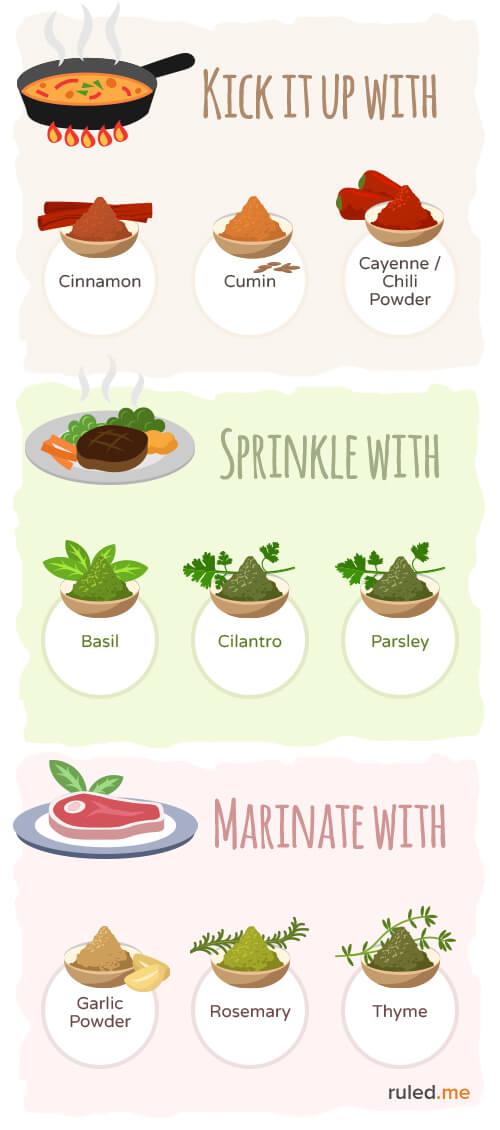
If you want to see some examples of recipes where we use spices, feel free to look at our ever-growing library of keto recipes >
Condiments and Sauces
Below, you'll find a visual idea of condiments that are commonly consumed on a ketogenic diet. Sometimes there is a lot of added sugar in just a teaspoon of sauce; double check nutrition labels to make sure it fits into your macros.
Sauces, gravies, and condiments, on the whole, have a lot of a gray area on keto. Generally, if you want to be strict, you should avoid all pre-made sauces and condiments unless listed below. They can have added sugars or use sweeteners that aren't friendly on the ketogenic diet.
If you choose to make your sauces and gravies, you should consider investing in guar or xanthan gum. It's a thickener that's well known in modern cooking techniques and lends a hand to low carb by thickening otherwise watery sauces. Luckily there are many sauces to choose from that are high fat and low carb. If you're in need of a sauce then consider making a beurre blanc, hollandaise or simply brown butter to top meats with.
Although great in health and theory, you may be like many others and not have the schedule to be able to make everything from scratch. Although it varies from brand to brand (make sure to read the ingredients), standard pre-made condiments for keto include:
- Ketchup (choose low, or no sugar added)
- Mustard
- Hot Sauce
- Mayonnaise (choose cage-free and avocado oil where possible)
- Sauerkraut (choose low, or no sugar added)
- Relish (choose low, or no sugar added)
- Horseradish
- Worcestershire Sauce
- Salad Dressings (choose fattier dressings like ranch, caesar, and unsweetened vinaigrettes)
- Flavored Syrups (choose acceptable sweeteners)
Try to err on the side of caution when it comes to keto condiments that are pre-made. Make your sauces and gravies using thickeners, and try to make your own condiments where applicable. Always double check the nutrition and ingredient list on your food to make sure that it fits in with your dietary requirements.

If you need some more ideas on how to use sauces and condiments in recipes, consider reading our keto cheat sheet >
Sweeteners
Below, you'll find a visual list of sweeteners that are commonly consumed on a ketogenic diet. Note that the less accepted they are, the less you will want to consume.
Staying away from anything sweet tasting is the best bet – it will help curb your cravings to a minimal level, which essentially promotes success on the ketogenic diet. If you have to have something sweet, though, there are some options available to choose from.
When searching for sweeteners, try to go after liquid versions as they don't have added binders (such as maltodextrin and dextrose). These are commonly found in blends like Splenda and can add up in carbs very, very quickly. For keto, you want to try to stick with lower glycemic index sweeteners.
Please note that this is just a small list of sweeteners that people use on keto. There's tons of different brands and blends out there – we frequently use a mixture of stevia and erythritol in our dessert recipes. You may find something that suits your tastes better, though, just make sure that it is on the acceptable sweetener list.
Typically you want to stay away from any brands that use filler ingredients like maltodextrin and dextrose, or high glycemic sweeteners like maltitol. Many low-carb products that claim low net carbs usually use these sugar alcohols. Many candies that are "sugar-free" also use these sweeteners. Avoid them where possible. These specific sweeteners respond in our body in a similar way sugar does.

When a sweetener has a low glycemic impact (or a low glycemic index), it has little effect on blood sugar. The higher the glycemic index is, the higher your blood sugar will spike during consumption. Here's our recommended list of 0 GI sweeteners:
- Stevia. One of the most common sugar substitutions used on the market today. Incredibly sweet with no glycemic impact. The liquid form is preferred.
- Sucralose. A very easy, but very sweet substitution to sugar that has a lot of misinformation around it. Many people confuse this with Splenda, but sucralose is the pure sweetener. Liquid versions are preferred.
- Erythritol. This is a great sugar substitution that has 0 glycemic impact. It's special because it passes through our bodies undigested, and is excreted without absorbing the carbs.
- Monk fruit. This is a less common sweetener and usually used in combination with others. While somewhat rare, if you can find it, it makes a great balanced sweetener.
- Various blends.There are numerous brands on the market that combine these sweeteners in their ratios. Be careful and read the ingredients.
For those looking for something just a little closer to real sugar, you can use Xylitol. It cooks and tastes very similar to sugar, but it has a slight glycemic impact (13 vs. 100 for sugar). It is great, but please keep in mind that it is very toxic to animals and it will raise insulin levels slightly. These are the two most cited reasons for not using Xylitol.
If you want a more detailed list of the best and worst sweeteners to use on keto, click here >
Cravings and Sugar Addiction
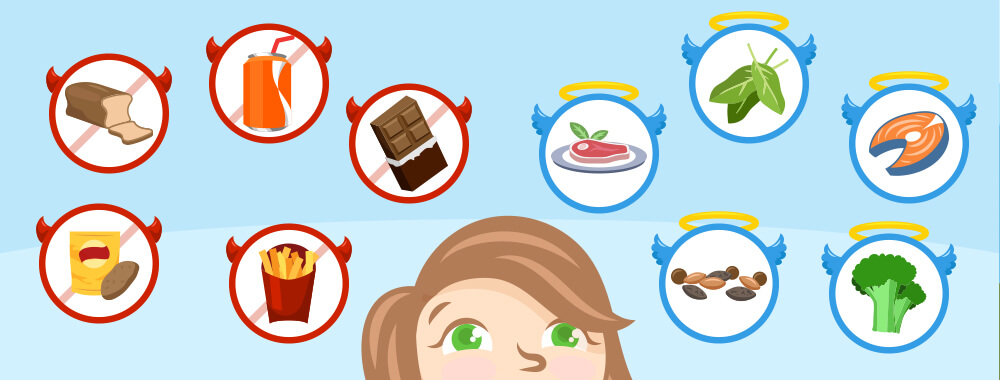
Most of the cravings that we get are caused by sugar. Sugar, at the end of the day, is an industry that's run on addiction. There have been numerous studies showing that sugar stimulates the reward centers of the brain.
When we constantly consume sugar, we release dopamine in our brain – creating an addiction and an increased tolerance. Over time you will have to eat larger and larger amounts of sugar to continue the dopamine secretion. Once our body is dependent on a chemical reaction in the brain, we can find that we're craving things even when we're not hungry.
When trying to shift from a high carb diet to a ketogenic diet, cravings can definitely get strong. It's always best to try to clean house before you start so that you don't have food around you that can lead to cravings. We recommend that when switching to keto, you restrict using sweeteners completely for the first 30 days. It normally leads to breaking sugar addiction and ultimately not having cravings.
Besides sugar, sometimes our bodies crave food because of lack of nutrients. The craving usually goes away if you fulfill your nutrient intake in a different way. Below you'll see a few ways to get rid of pesky cravings that hit.
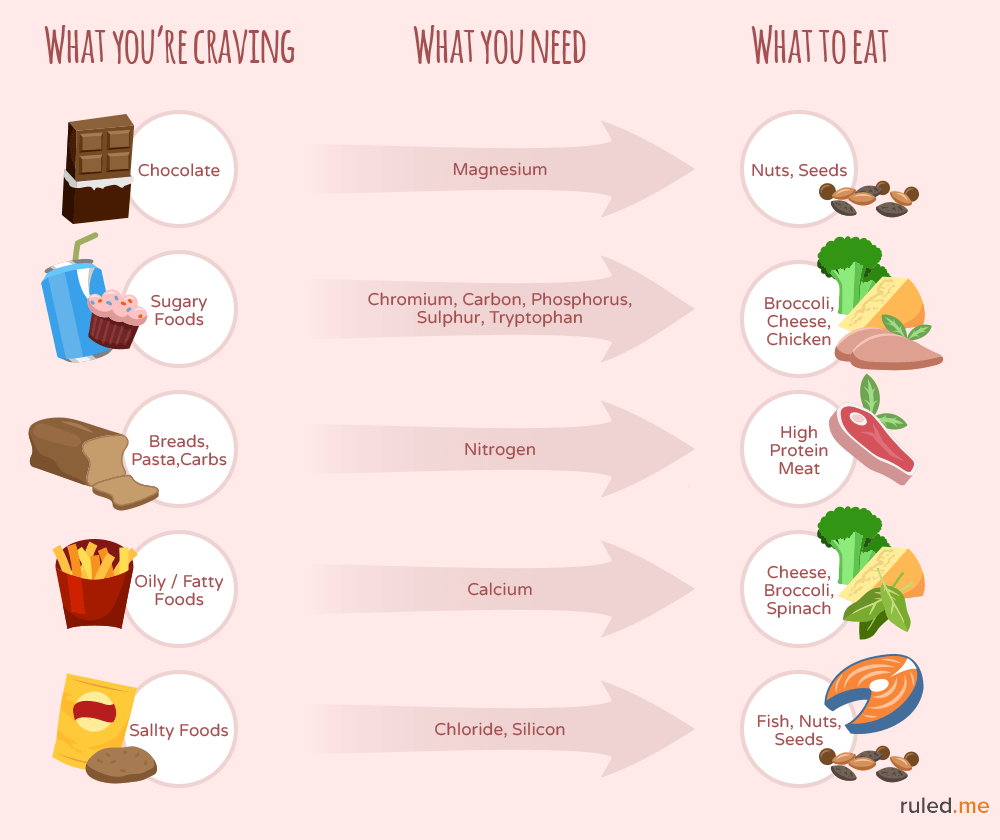
Hidden Carbs and Nutrition Labels
Going on a ketogenic diet can be very difficult in the very beginning. Knowing what to eat and what not to eat takes some time to get used to, so if you make some mistakes in the beginning don't be too hard on yourself. It's better to make a mistake and learn from it than to make a mistake and not realize it was in error.
There's always going to be foods that are bad for us when it comes to eating. Some foods are particularly sneaky at hiding carbohydrates from us. Here's a small list of common items that sometimes have hidden carbs:
- Low-carb products. There's a lot of choices when it comes to bars, snacks, and foods. It's better to stay away from these, but if you have no choice make sure to read the label. Many use high glycemic index sweeteners in their products.
- Spices. As mentioned above, spices do have carbs – but certain ones have more carbs than others. These include onion powder, cinnamon, garlic powder, allspice, and ginger. Always read labels and make sure no added sugar are in your spice blends.
- Fruit and berries. Most fruits are not allowed to be consumed due to the high sugar content. Many people still eat berries, but you have to control your portioning with these. Be careful blueberries and cranberries as they add up in carbohydrates fast.
- Tomato-based products. Lots of people use tomato sauces and canned diced tomatoes. Make sure to read the nutrition labels – food companies are infamous for messing with serving sizes to make their foods seem "healthier." Make sure that there are no added sugars.
- Condiments. It's almost tradition to add sauce to a meal – but be careful about your favorites. Sometimes condiments and sauces can show minuscule serving sizes which skew the actual carbs that are inside. Make sure you read the nutrition and ingredient lists well.
- Peppers and chiles. Be very careful when you use small peppers as sometimes they can be incredibly sweet inside. There can sometimes be 3-4g carbs in a tiny chili pepper. When using bell peppers, try to opt for green as red/yellow bell peppers will have slightly more carbs.
- Diet soda. You can drink diet soda, but it's recommended to cut it out completely. Some people report being knocked out of ketosis after a large consumption of artificial sweeteners. Studies also show a link between sugar cravings and artificial sweeteners – cutting the soda out will help curb your cravings.
- Chocolate. You can eat chocolate on keto, but you have to be very cautious with the serving sizes. You want to stick to very dark chocolate (90% or higher), as this will have much fewer carbs.
- Medicine. Cold medications, cough syrups, and flu remedies often contain lots of sugar. Some of the generic over the counter cough medicines contain 20g of carbs per serving, so be very careful when sick. There are usually sugar-free or diabetic alternatives.
There are so many food items out there that contain hidden sugars and carbs. Always be careful about what you're purchasing and try to make as much from scratch as you can from home.
Foods to Avoid

By now, you should have a pretty good idea of what to eat on a ketogenic diet. Make sure that you read and re-read through the list of acceptable foods to build a mental image around what type of meals you will want to eat.
If you're still unsure about any products or food items that might not be keto friendly, don't worry too much. Below, you'll find a list of things that you should always be on the look out for.
- Sugar. It's typically found in soda, juice, sports drinks, candy, chocolate, and ice cream. Anything that's processed and sweet you can think of most likely contains sugar. Avoid sugar at all costs.
- Grains. Any wheat products (bread or buns), pasta, cereal, cakes, pastries, rice, corn, and beer should be avoided. This includes whole grains like wheat, rye, barley, buckwheat, and quinoa.
- Starch. Avoid vegetables (like potatoes and yams) and other things like oats, muesli, etc. Some root vegetables are okay in moderation – be sure to read the section on vegetables.
- Trans Fats. Margarine or any other spreadable replacement butter should be avoided as they contain hydrogenated fats (bad for us).
- Fruit. Avoid any large fruits (apples, oranges, bananas) as they're extremely high in sugar. Some berries can be consumed in moderation – be sure to read the section on fruits.
- Low-fat foods. These tend to be much higher in carbs and sugar than full-fat versions. Make sure you read the package to make sure a mistake isn't made.
In general, the more "real" the food, the better it is for you. While some processed foods are acceptable, many are not. Make sure that you read through the ingredients and nutrition information to make sure that it can fit within your diet.
Source: https://www.ruled.me/ketogenic-diet-food-list/